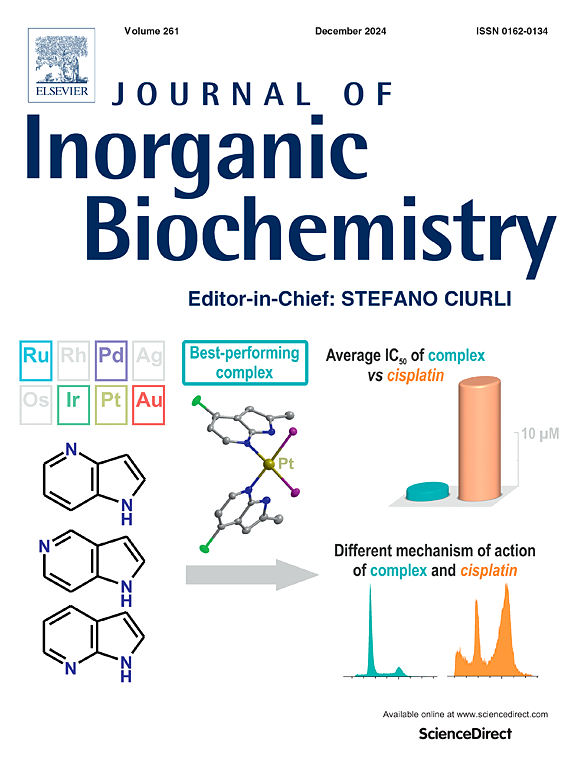Multiple catalytic functions of an engineered double mutant of myoglobin with a potential metal-binding site
IF 3.2
2区 化学
Q2 BIOCHEMISTRY & MOLECULAR BIOLOGY
引用次数: 0
Abstract
Rational protein engineering has emerged as a powerful tool for creating functional enzymes, and the design of metalloenzymes with dual active sites is particularly attractive. In this study, we performed a double mutation of F46H/L49D in the helices C and D region in myoglobin (Mb). As demonstrated by X-ray crystallography, the double mutations preserved the overall Mb fold and formed a potential metal-binding site, located ∼15 Å from the heme iron, which enable the protein to bind various metal ions such as Cu2+, Mg2+ and others. Moreover, the binding of Cu2+/Mg2+ conferred multiple enzymatic activities to F46H/L49D Mb. The Cu2+-F46H/L49D Mb complex exhibited significant nitrite reductase and superoxide dismutase activities. Notably, the protein exhibited DNA cleavage activity in the presence of Mg2+, achieving nearly 100 % cleavage efficiency within 30 min. By demonstrating the versatility of the engineered metal-binding site in Mb, this study suggests that rational design can expand the functional repertoire of the protein. The F46H/L49D Mb mutant serves as a versatile platform for studying metal-dependent catalysis of artificial metalloenzymes with non-heme/heme dual active sites, offering potential applications in biocatalysis, medicine, and industrial catalysis.

具有潜在金属结合位点的肌红蛋白工程双突变体的多重催化功能
理性蛋白工程已成为创造功能性酶的有力工具,而设计具有双活性位点的金属酶尤其具有吸引力。在这项研究中,我们在肌红蛋白(Mb)的螺旋C和D区进行了F46H/L49D的双突变。x射线晶体学显示,双突变保留了整个Mb折叠,并形成了一个潜在的金属结合位点,位于血红素铁的~ 15 Å处,使蛋白质能够结合各种金属离子,如Cu2+, Mg2+等。此外,Cu2+/Mg2+的结合赋予F46H/L49D Mb多种酶活性。Cu2+-F46H/L49D Mb复合物具有显著的亚硝酸盐还原酶和超氧化物歧化酶活性。值得注意的是,该蛋白在Mg2+存在下表现出DNA切割活性,在30分钟内达到近100%的切割效率。通过展示Mb工程金属结合位点的多功能性,本研究表明合理的设计可以扩展蛋白质的功能库。F46H/L49D Mb突变体为研究具有非血红素/血红素双活性位点的金属依赖性人工金属酶的催化作用提供了一个多功能平台,在生物催化、医学和工业催化方面具有潜在的应用前景。
本文章由计算机程序翻译,如有差异,请以英文原文为准。
求助全文
约1分钟内获得全文
求助全文
来源期刊

Journal of Inorganic Biochemistry
生物-生化与分子生物学
CiteScore
7.00
自引率
10.30%
发文量
336
审稿时长
41 days
期刊介绍:
The Journal of Inorganic Biochemistry is an established international forum for research in all aspects of Biological Inorganic Chemistry. Original papers of a high scientific level are published in the form of Articles (full length papers), Short Communications, Focused Reviews and Bioinorganic Methods. Topics include: the chemistry, structure and function of metalloenzymes; the interaction of inorganic ions and molecules with proteins and nucleic acids; the synthesis and properties of coordination complexes of biological interest including both structural and functional model systems; the function of metal- containing systems in the regulation of gene expression; the role of metals in medicine; the application of spectroscopic methods to determine the structure of metallobiomolecules; the preparation and characterization of metal-based biomaterials; and related systems. The emphasis of the Journal is on the structure and mechanism of action of metallobiomolecules.
 求助内容:
求助内容: 应助结果提醒方式:
应助结果提醒方式:


